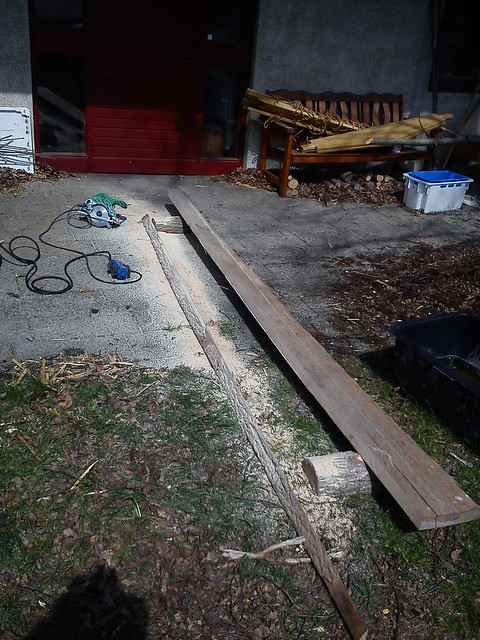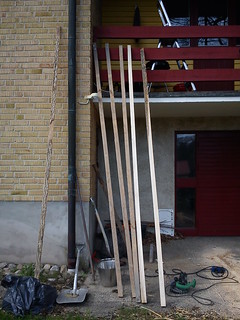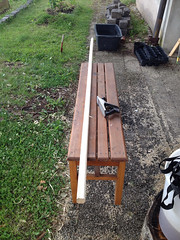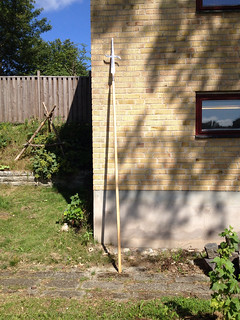| Author |
Message |
Jared Smith

|
 Posted: Sat 19 Jul, 2014 8:37 pm Post subject: How are staves for lances and spears selected and prepared? Posted: Sat 19 Jul, 2014 8:37 pm Post subject: How are staves for lances and spears selected and prepared? |
 |
|
How do the historical joust and spear wielding reenactors obtain and prepare ash staves or saplings for spears and lances?
Our middle Tennessee archeological park tour guides teach that the "indians" in this area submerged fairly straight, long reeds and poles in water to soften them. Then during summer they suspended those by hemp rope with rocks lashed at the bottom while drying such that gravity did the work of straightening them while they cured.
I imagine, but do not know, if any historical lances or spears have been examined to determine if they were complete saplings (full circular growth rings remaining in the cross sections), or if they were prepared like bow staves. I would be interested in what various peoples "practical" current day solution is, and if any have similarly tried to examine and answer what it appears that the historical method was.
Sincere thanks to anyone who has spent time researching this and is willing to share their solutions and ideas.
Absence of evidence is not necessarily evidence of absence!
|
|
  |
 |
Matthew Bunker

Location: Somerset UK Joined: 02 Apr 2009
Posts: 483
|
 Posted: Mon 21 Jul, 2014 1:40 am Post subject: Posted: Mon 21 Jul, 2014 1:40 am Post subject: |
 |
|
In the studies and reports that I've read (covering the 3rd to the 11th century) every example of a Western European spear socket which has wooden remains inside it has shown that the shaft was worked down from a split plank, not from a coppiced branch.
So that's how I get mine.
Shafts made from coppiced branches are too flexible to be of much use for a weapon which was primarily used for thrusting. It would be different for javelins, where the main consideration would be weight.
"If a Greek can do it, two Englishman certainly can !"
|
|
  |
 |
|
William P
|
 Posted: Mon 21 Jul, 2014 4:56 am Post subject: Posted: Mon 21 Jul, 2014 4:56 am Post subject: |
 |
|
the byzantine menavlion may be an exception, the military manuals of the time (10th century onwards) seem to specify the want for the use of something not of prehewed timber I believe, although i dont remember the exact description.
it was also not normal spear size, being 'as thick as one can comfortably grip, which most people to tae as being 2 inches in diameter.
however this was a highly specialised spear with its parts selected in order to be able to take themassive force of a charging cataphract. and thus i don't think its indicative of normal spear manufacture.
aside from that i know of no examples.
|
|
   |
 |
Bjorn Hagstrom

|
 Posted: Mon 21 Jul, 2014 6:33 am Post subject: Posted: Mon 21 Jul, 2014 6:33 am Post subject: |
 |
|
This is how I made a few of mine:
One 3,5 m long ash plank, approx 2 inches thick. This was a beautiful, straight grained knot-free plank.
I split it into 2 inch thick pieces (using a not so historically correct circular saw), giving me at total of 5 or so 3,5 ash 2 by 2
Then using hand plane and drawknife to shape. I have made almost all my shafts and hafts from these. For maces, spears, halberds, and the last and longest: One 11 foot kurzgewehr (of Great Northern War era)




There is nothing quite as sad as a one man conga-line...
|
|
   |
 |
Matthew Bunker

Location: Somerset UK Joined: 02 Apr 2009
Posts: 483
|
 Posted: Tue 22 Jul, 2014 1:14 am Post subject: Posted: Tue 22 Jul, 2014 1:14 am Post subject: |
 |
|
| William P wrote: | | the byzantine menavlion may be an exception, . |
At three meters long and made form whole oak saplings, yes, I think they probably were.
"If a Greek can do it, two Englishman certainly can !"
|
|
  |
 |
|
William P
|
 Posted: Tue 22 Jul, 2014 1:41 am Post subject: Posted: Tue 22 Jul, 2014 1:41 am Post subject: |
 |
|
| Matthew Bunker wrote: | | William P wrote: | | the byzantine menavlion may be an exception, . |
At three meters long and made form whole oak saplings, yes, I think they probably were. |
according to tim dawsons calculations, it was actually only around 8 ft, which is pretty normal for spears if i remember correctly and is pretty puny compared to the 4.5 - 5 meter pikes used by the average byzantine infantryman. what made it exception is its thickness of around 2 inches, that and its construction of being made specifically from saplings.
which does make it quite heavy.
http://www.levantia.com.au/military/Dawson_Fit_for_the_Task.pdf this is a link to his calculations
|
|
   |
 |
|
Andrew W
Location: Florida, USA Joined: 14 Oct 2010
Posts: 79
|
 Posted: Wed 23 Jul, 2014 12:36 pm Post subject: Posted: Wed 23 Jul, 2014 12:36 pm Post subject: |
 |
|
Many of the spears found in 5-7th century Anglo-Saxon graves used coppiced wood (saplings). I haven't gotten around to adding up the numbers for coppice vs. mature (ie, cut down to the desired size and shape) timber in the 40-odd sites I'm studying, but it seems very roughly evenly distributed between the two methods.
Presumably, the coppiced wood will be pretty straight to begin with, especially if you are growing timber for firewood and select the straightest saplings when they're the right age to use for spears. But i wouldn't be surprised if some of them are being straightened in a manner similar to what you describe.
|
|
  |
 |
Matthew Bunker

Location: Somerset UK Joined: 02 Apr 2009
Posts: 483
|
 Posted: Wed 23 Jul, 2014 2:21 pm Post subject: Posted: Wed 23 Jul, 2014 2:21 pm Post subject: |
 |
|
| Andrew W wrote: | | Many of the spears found in 5-7th century Anglo-Saxon graves used coppiced wood (saplings). |
That's very interesting. I've got a fair collection of site reports so could you name a few that I can cross check against?
Thanks
"If a Greek can do it, two Englishman certainly can !"
|
|
  |
 |
Bjorn Hagstrom

|
 Posted: Thu 24 Jul, 2014 1:45 am Post subject: Posted: Thu 24 Jul, 2014 1:45 am Post subject: |
 |
|
Slightly off topic, but related:
There was supposedly (I'll have to check my sources) a tradition in pre-industrial rural sweden, that a newly wed man would find a suitable tree on his property, and chisel deep scores lengthwise along the trunk. The wood would form bulging welts along the scores with time. These welts would in 15-20 years time be ready to harvest for shaft materials.
The idea being that by that time, his first son would be ready to move out and form his own household, and could bring good hafts for rakes, spades and other farming tools with him. As hopefully his father got from the generation previously.
This practice lends itself much better to small scale production and a long planning horizon, so would likely never been used for ancient warfare. Long term and large scale forest management seem to appear when fleets and ship building becomes a big thing (At least in Scandinavia, Oaks, beech and fruit bearing trees has been subject to various laws from the 14th century, governing who could cut them down, and for what use)
On topic:
I have tried making spear shafts of saplings, and no matter how straight they look, even with planing and smoothing, they end up more or less crooked. I have never really made a serious attempt of straightening them out. But have anyone else? Have you been using steam or dry heat to do it? Any insights to shorten my trial and error attempts would be appreciated 
There is nothing quite as sad as a one man conga-line...
|
|
   |
 |
|
Andrew W
Location: Florida, USA Joined: 14 Oct 2010
Posts: 79
|
 Posted: Thu 24 Jul, 2014 2:17 pm Post subject: Posted: Thu 24 Jul, 2014 2:17 pm Post subject: |
 |
|
| Matthew Bunker wrote: | | Andrew W wrote: | | Many of the spears found in 5-7th century Anglo-Saxon graves used coppiced wood (saplings). |
That's very interesting. I've got a fair collection of site reports so could you name a few that I can cross check against?
Thanks |
I'm on a dig at the moment (Lyminge) and don't have many of my sources scanned to check, but I know West Heslerton had both mature and coppiced trees for shafts. There are more sites I've encountered with coppiced shafts, but I don't have good notes with me in the field. I'd be happy to share more sources with you when I get back, sometime in late August.
|
|
  |
 |
Jared Smith

|
 Posted: Thu 24 Jul, 2014 9:40 pm Post subject: Posted: Thu 24 Jul, 2014 9:40 pm Post subject: |
 |
|
Thanks much for the responses. I am glad to hear of the existence of coppiced finds. (We are talking of complete growth rings in cross section?)
I would reason that full concentric growth ring cross sections should be theoretically best (resistant to buckling as a whole tree is when bending or under wind stress), but not necessarily prioritized as growth ring direction was in bow making since a lance or spear was more frequently expended.
The next question I would have no idea of, but the people working in the field there might be able to ascertain as obvious would be if availability of straight whole saplings is just a characteristic of the woods in in regions where whole growth ring shafts are found, or if it seems that the woods may have been managed or groomed and pruned to yield them (as some US sources of Osage Orange for bows are today.)
Absence of evidence is not necessarily evidence of absence!
|
|
  |
 |
Matthew Bunker

Location: Somerset UK Joined: 02 Apr 2009
Posts: 483
|
 Posted: Fri 25 Jul, 2014 11:28 am Post subject: Posted: Fri 25 Jul, 2014 11:28 am Post subject: |
 |
|
| Andrew W wrote: | | West Heslerton had both mature and coppiced trees for shafts.. |
So it has! Interesting.
I'd only previously noticed a high incidence of mature wood shafts when looking at sites in the South and South East and the absence of any sort of pollarded shaft in the Scando-Germanic spears of the bog deposits.
I wonder of there's a correlation between type of wood used and spear size or with the 'status' of the grave...or regionality.
"If a Greek can do it, two Englishman certainly can !"
|
|
  |
 |
|
Danilo J
Location: Pirot, Serbia Joined: 28 Feb 2018
Posts: 28
|
 Posted: Mon 13 Sep, 2021 6:50 am Post subject: Posted: Mon 13 Sep, 2021 6:50 am Post subject: |
 |
|
| Bjorn Hagstrom wrote: | On topic:
I have tried making spear shafts of saplings, and no matter how straight they look, even with planing and smoothing, they end up more or less crooked. I have never really made a serious attempt of straightening them out. But have anyone else? Have you been using steam or dry heat to do it? Any insights to shorten my trial and error attempts would be appreciated  |
Resurrecting an old thread:
Right now, I am where you were all those years ago xD
I just cut 3 very straight shoots of hazel for spear shafts, but theyre wonky upon closer inspection.
Its a bit early, I know, so theyre full of moisture still.
Any idea how to best straighten them and when?
|
|
   |
 |
|
Sean Manning
|
 Posted: Mon 13 Sep, 2021 10:24 am Post subject: Posted: Mon 13 Sep, 2021 10:24 am Post subject: |
 |
|
| Danilo J wrote: |
I just cut 3 very straight shoots of hazel for spear shafts, but theyre wonky upon closer inspection.
Its a bit early, I know, so theyre full of moisture still.
Any idea how to best straighten them and when? |
You can find descriptions in:
Sekunda, Nicholas Victor (2001) “The Sarissa.” Acta Universitatis Lodziensis, Folia Archaeologica 23
pp. 13–41 http://hdl.handle.net/11089/7892
and the Brill book by Waldman on hafted weapons (I think that book describes making the staves from wedges of tree not coppiced shoots).
weekly writing ~ material culture
|
|
  |
 |
|
Danilo J
Location: Pirot, Serbia Joined: 28 Feb 2018
Posts: 28
|
 Posted: Thu 16 Sep, 2021 8:30 am Post subject: Posted: Thu 16 Sep, 2021 8:30 am Post subject: |
 |
|
Thanks Shawn, Ill look into it.
I know how it was done, probably, cause my grandpa still uses pretty much the same technique to make axe handles.
Its tougher however, to find such long straight pieces of wood required for a spear and I just stumbled upon these 3 shoots that were begging to be used just for this 
|
|
   |
 |
Dan Howard

|
 Posted: Sun 26 Sep, 2021 3:52 pm Post subject: Posted: Sun 26 Sep, 2021 3:52 pm Post subject: |
 |
|
You can't just pick the right type of wood. Commercial timber comes from plantations where the trees are grown as rapidly as possible. This reduces the strength of the wood. Planks and dowels aren't suitable either because they don't have intact growth rings, which further compromises the strength. The best spear shafts come from saplings and coppiced branches from slow-growing trees. You don't need fancy tools - I've made them using nothing except a sharp machete and sandpaper.
Author: Bronze Age Military Equipment, Pen and Sword Books
|
|
  |
 |
|
|

